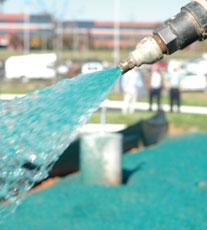EFMs: Better than blankets
“Spray It, Don’t Lay It”: Why EFMs are a better alternative to blankets.

The shift continues from outdated turf establishment blankets to modern hydraulically applied products, like the new ProMatrix™ Engineered Fiber Matrix (EFM). More agencies and specifiers are “rolling up their blankets” and making the switch to hydraulics.
What is driving this change?
- Superior erosion control performance
- Better growth establishment
- Ease and speed of application
- Reduced grading costs
- Project cost savings
- Improved site aesthetics
- Environmental superiority
Earth-Friendly Facts
Scientific analysis, using published performance parameters, the Revised Universal Soil Loss Equation (RUSLE) and ASTM standards, along with typical construction practices prove:
- By using a Profile® ProMatrix, you can expect 3 times more germination based on ASTM D7322 testing results when compared to double-net straw blankets.
- By using a Profile ProMatrix, you can expect 2 times less soil loss when compared to double-net straw blankets.
Simplified Installation
Installing double-net straw blankets on a large erosion control site would take approximately 4 times longer than installing ProMatrix. (Noting that approximately 6,000 square yards of double-net straw can be applied in a day versus approximately 25,000 square yards of ground can be covered in a day with ProMatrix.)
Aside from the time and cost savings associated with the installation of ProMatrix versus double-net straw blankets, the following additional benefits exist:
- Effective without smoothing the site surface. (Having a rough surface minimizes erosion while the soil irregularities provide pockets for holding moisture and improving growth establishment.)
- Can be applied without direct site access via long range tower spraying.
- Eliminates the cost and labor of staking/pinning of blankets.
- Forms an intimate bond with the soil surface.
Earth-Friendly Fact #2
By specifying/installing ProMatrix instead of a turf establishment blanket, you will not introduce plastic netting into the environment that leads to a messy project site with the potential for wildlife entanglement.



